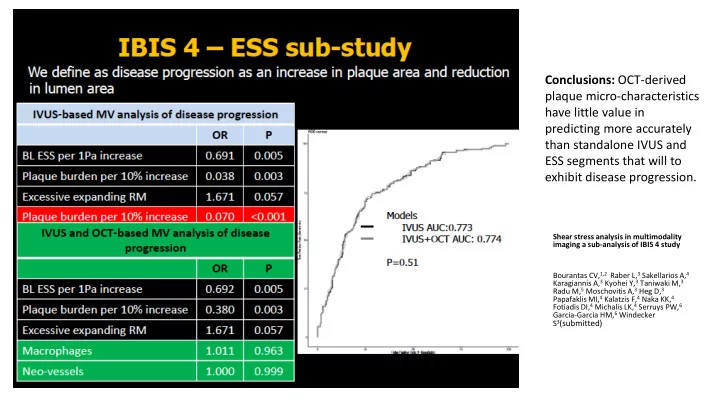

IBIS 4 Substudy Conclusions: OCT-derived plaque micro-characteristics have little value in predicting more accurately than standalone IVUS and ESS segments that will to exhibit disease progression. Shear stress analysis in multimodality imaging a sub-analysis of IBIS 4 study Bourantas CV, 1,2 Raber L, 3 Sakellarios A, 4 Karagiannis A, 3 Kyohei Y, 3 Taniwaki M, 3 Radu M, 5 Moschovitis A, 3 Heg D, 3 Papafaklis MI, 4 Kalatzis F, 4 Naka KK, 4 Fotiadis DI, 4 Michalis LK, 4 Serruys PW, 6 Garcia-Garcia HM, 6 Windecker S 3 (submitted)
IVUS-based Tissue Characterization and ESS: PREDICTION of events Incremental value of combined ESS, necrotic core and plaque burden for prediction of clinically-relevant events Papafaklis et al. Int J Cardiol 2016
PROSPECT Study. Role of low endothelial shear stress and plaque characteristics in the prediction of nunculprit major adverse cardiac events. CONCLUSIONS Local low ESS provides incremental risk stratification of untreated coronary lesions in high-risk patients, beyond measures of PB, MLA, and morphology. Lesion with normal SS regardless of their characteristis (PB, MLA or lesion phenotype did not develop MACE at follow-up Low ESS regardless the characteristics of the lesions: 22% possibility of developing Role of Low Endothelial Shear Stress and Plaque Characteristics in the Prediction of Nonculprit Major Adverse Cardiac Events The PROSPECT Study MACE Peter H. Stone, MD, Akiko Maehara, MD, Ahmet Umit Coskun, PHD, Charles C. Maynard, PHD, Marina Zaromitydou, MD, PHD, Gerasimos Siasos, MD, PHD, Ioannis Andreou, MD, PHD, Dimitris Fotiadis, PHD, Kostas Stefanou, Lesions of high risk and Low ESS: PHD, Michail Papafaklis, MD, PHD, Lampros Michalis, MD, PHD, Alexandra J. 58% possibility of developing MACE Lansky, MD, Gary S. Mintz, MD, Patrick W. Serruys, MD, PHD, Charles L. Feldman, SCD, Gregg W. Stone, MD JACC: CARDIOVASCULAR IMAGING VOL. -, NO. -, 2017
Conclusion Which is the accuracy of prediction future events: • FFR: 18% • IVUS anatomic characteristics + Virtual Histology: 18% • IVUS anatomic characteristics + ESS: 50% • IVUS anatomic characteristics + Virtual Histology + ESS: 52% -58%
In Intravascular Im Imaging coupled wit ith physiology vs vs FFR Intravascular Imaging coupled with Physiology is a new tool which possibly predicts new events better than FFR However we need more studies in order to prove it. We have the tools which can couple Intravascular Imaging with Physiology reliably and quickly enough.
Can we use CTCA in a similar fashion with IVUS + physiology? PROSPECT – MSCT Study. Summary: The present analysis for the first time investigated the potential value of MSCT-derived plaque characteristics in identifying lesions that are likely to progress at 3-year follow-up. We found that: 1) low ESS and increased baseline lumen area were predictors of lumen decrease at follow-up; 2) decreased plaque area and burden were independently associated with an increase in plaque area at follow-up; 3) low ESS and decreased plaque area and burden and increased calcific tissue component were independently related with an increase in plaque burden at follow-up; and 4) a low plaque area and burden and an increased fibrofatty and fibrous tissue component were independently related to an JACC Cardiovasc Imaging. 2016 Aug;9(8):1009-11. doi: 10.1016/j.jcmg.2015.07.005. Epub 2015 Sep 9. increase in the necrotic core at follow-up. Noninvasive Prediction of Atherosclerotic Progression: The PROSPECT- MSCT Study. Bourantas CV, Papadopoulou SL, Serruys PW, Sakellarios A, Kitslaar PH, Bizopoulos P, Girasis C, Zhang YJ, de Vries T, Boersma E, Papafaklis MI, Naka KK, Fotiadis DI, Stone GW, Reiber JH, Michalis LK, de Feyter PJ, Garcia-Garcia HM.
Can we measure ESS from 3D QCA reliably? Mpourantas, … ., Michalis et al: European J CardioVasc Imag, 2018
FINAL CONCLUSION • We are moving towards a new era • The whole concept is accurate as possible prediction of new events in order to establish pre-emptive treatments • It seems that we can predict up to 58% from 18% who is the accepted value till now • It seems that we will be able to get this results non-invasively
Thank you for your attention
Recommend
More recommend